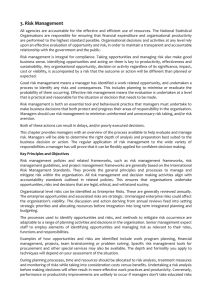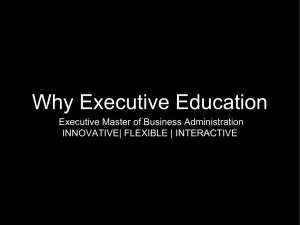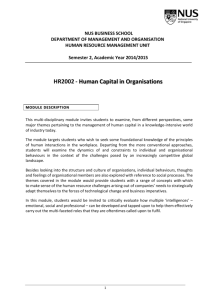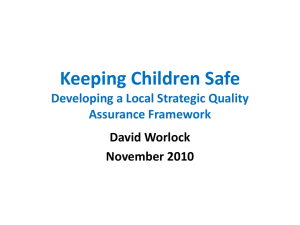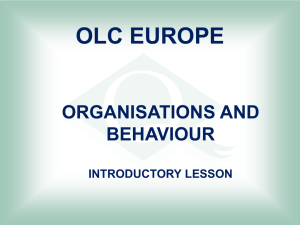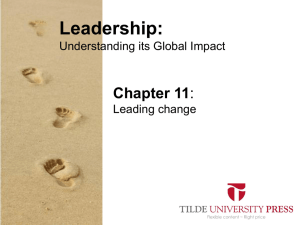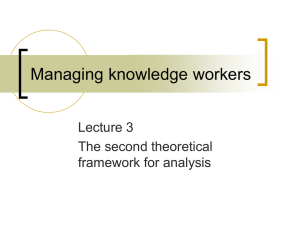Chapter Slides
advertisement
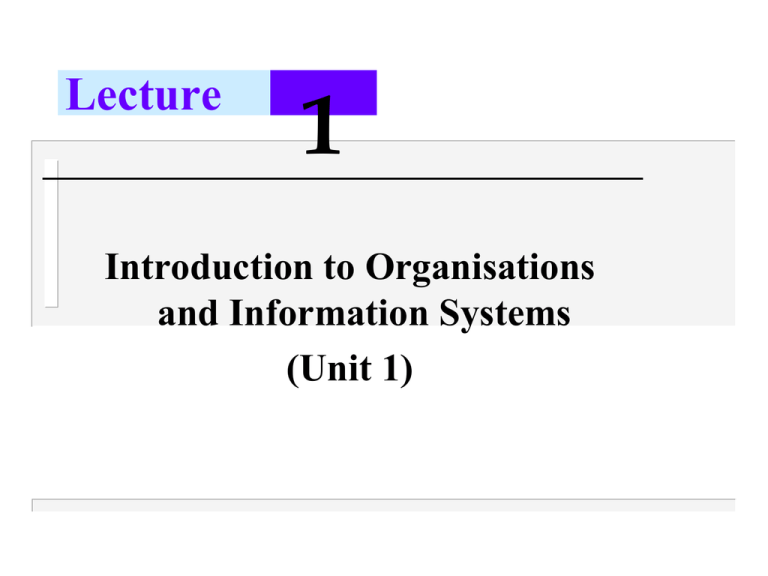
Lecture 1 Introduction to Organisations and Information Systems (Unit 1) Organisations a collection of interacting and interdependent individuals who work towards common goals and whose relationships are determined according to a common structure" (Duncan, 1981) 2 An aspirational view Organisation A general expression of the overall purpose Vision Mission Statement Goals and Objectives 3 Why do organisations exist? Organisational theories Organisational Structure Objective of the organisational structure Means of attaining objectives and goals The extent to which, and the ways in which, one is controlled and 5 constrained New Business Models Multinational companies International organisations Virtual global companies Page 336 of Turban et al. Enterprise 6 Multinational companies Sometimes referred to as a "transnational corporation". A good summary is given at: http://www.investopedia.com/terms/m/multinati onalcorporation.asp WiseGEEK discuss different business models used: http://www.wisegeek.com/what-is-amultinational-corporation.htm Good description is given by bized: http://www.bized.co.uk/learn/economics/notes/ 7 multi.htm Organisation Structure Top management Chief executive Senior executive Middle management Department/division heads Superintendents Supervisory management General foremen First-line supervisors 8 Buchanan & Huczynski, 1997, Organisation Culture What is meant by the term ‘Culture’? a set of major understandings and assumptions shared by a group 9 Some Aspects of Culture (L.Aiman-Smith 2004) Historical: Culture is social heritage, or tradition, that is passed on to future generations Behavioural: Culture is shared, learned human behaviour, a way of life Normative: Culture is ideals, values, or rules for living 10 Functional: Culture is the way people solve problems of adapting to the environment and living together Mental: Culture is a complex of ideas, or learned habits, for social control Structural: Culture consists of patterned and interrelated ideas, symbols, or behaviours Symbolic: Culture is based on arbitrarily assigned meanings that are shared by an organization 11 Models of Culture Geert Hofstede – country culture – 5 dimensions – Culture’s Consequences (1980) –reprinted in 2001 O’Reilly, Chatman, and Caldwell (1991) – organisational culture – 7 dimentions Two dimensional framework – – internal or external focus flexibility and individuality or stability and control. 12 Organisational Reflects tension conflict between Order & Stability Demands of the internal system and those of the external environment 4 cultural types (Boddy et al., 2002) 13 Stability and Control Flexibility and Discretion Internally focused Externally focused This type of organization has a sense of cohesion, with goals that strongly shared. Inside, the organization may feel more ‘family like” than ‘business like.” Clan Culture – Cameron and Quinn (1999) Having Involvement of all employees(Denison, 1990) The emphasis on being open to change and oriented to the outside world characterizes organizations in which innovation can thrive, indeed sometimes the innovativeness can run amuck. Adhocracy Cultures -Cameron and Quinn (1999) High Adaptability cultures -(Denison, 1990) This type of organization often relies on formal structures, policies and procedures to keep things running. Hierarchy Culture - Cameron and Quinn (1999) An internal focus is on Consistency (Denison, 1990) These types of organizations are concerned about productivity, consistency, results, the bottom line. These organizations are very clear about their customers, and hence can be termed Market Cultures. (Denison, 1990) – These organizations have a sense of external Mission, combined with control, that can be very successful. (L.Aiman-Smith 2004) 14 Human relations Flexibility Computer-aided instruction Interpersonal computing and conferencing Group decision supporting Environmental scanning and filtering Inter-organisational linking Doubt and argument promoting Internal External Internal monitoring Internal controlling Record keeping Optimising Stability Survival Modelling Forecasting Sensitivity analysing Order (Boddy et al., 2002:173) 15 Productivity Environment Customers Suppliers Competitors Investors Regulators Technology Knowledge Organisation IS 16 (Adapted from Laudon and Laudon, 2006:78) Organisations vision resources people Mission Controlled performance Goals and objectives Organisational behaviour Structure Culture 17 Announcement Module Representatives 18 System Theory Developed by Ludwig von Bertalanffy in 1936 “System theory is the transdisciplinary study of the abstract organization of phenomena, independent of their substance, type, or spatial or temporal scale of existence. It investigates both the principles common to all complex entities, and the (usually mathematical) models which can be used to describe them” 19 What is a system? “A system is an entity which maintains its existence through the mutual interaction of its parts”. Ludwig von Bertalanffy ‘A group of interrelated components working together toward a common goal by accepting inputs and producing outputs in an organised transformation process’ (James o’Brien, 2004) 20 System Theory Organisation Input from the environment Output to the environment Production process Feedback 21 (adapted from Laudon and Laudon, 2006:73) Emergence Anasynthis (Introduction to Systems Thinking by Gene Bellinger at http://www.systemsthinking.org/systems/systems.htm ) Open systems Vs Closed systems Close-coupled systems 22 Capture Process Transmit The Functions of Information Technology (IT) Store/Retrieve Generate 23 James A. Senn, Page 23 Information systems are the means by which organisations and people, using information technologies gather, process, store, use, and disseminate information. (www.ukais.org) 24 Information Systems A Business IS (BIS) … convert data into information products that can be used to support forecasting, planning, control, coordination, decision making and operational activities in an organisation. – Bocij et al. 25 (O’Brien, 2004, page 11) The Components of an IS Control of system performance Input of data resources Processing data into information Output of information products Storage of data resources Network Resources Communications media and Network support 26 People resources IS Specialists - People who develop and operate IS, e.g. system analysts, software developers, system operators End Users - anyone who uses the information systems or the information it produces, e.g. customers, salespersons, managers (O’Brien, 6th Edition, page27 12) Software resources all sets of information processing instructions Programs - System software (operating system programs), Application software (spreadsheet programs, word processing programs, payroll programs, etc.) Procedures - data entry procedures, error correction procedures, paycheque distribution procedures, etc. 28 Hardware resources All physical devices and materials used in information processing Machines - Computers, video monitors, magnetic disk drives, printers, optical scanners, etc. Data Media - floppy disks, magnetic tapes, optical disks, plastic cards, paper forms, etc. (O’Brien, 6th Edition, page 12) 29 Network resources Communications media, Communications processes, Network access and control software, etc. (O’Brien, 6th Edition, page 12) 30 Data resources Product descriptions, Customer records, Employee files, Inventory Databases, Organisational knowledge bases External data warehouses, etc. (O’Brien, 6th Edition, page 12-13) 31 Data Vs Information Application programs Vs IS IS Vs IT (ICT) Used To Build Hardware Software Databases Networks other related components Read Chapter 1 Page 18 ff of Turban et al. 32 IS IT Application programs Data People Information Knowledge Decisions experience Actions 33

